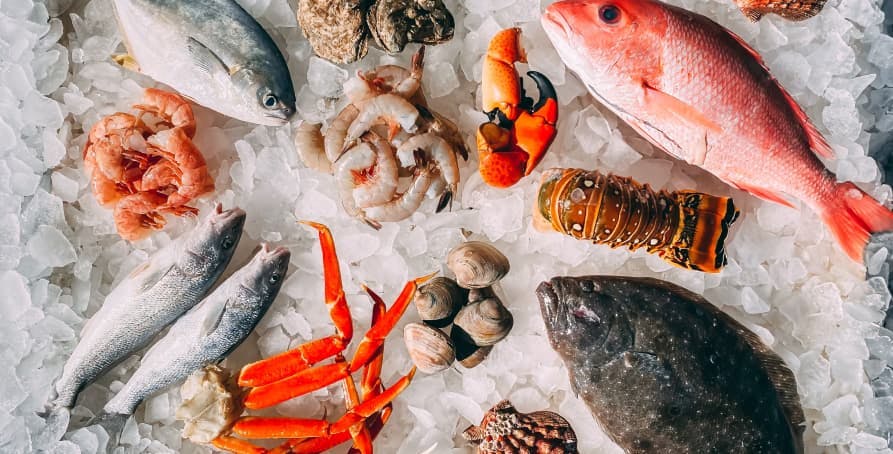ESG / CSR
Industries
What is the Atlantic Meridional Overturning Circulation (AMOC)?



If you’ve ever wondered why the temperature of the ocean changes depending on where you are and what time of year it is – then the AMOC, or the Atlantic Meridional Overturning Circulation, might be your answer.
The ocean makes up 71% of our Earth’s surface, and is not only a selling point for many cities and tourist destinations – but is home to copious amounts of marine life, which helps to keep biodiversity and our ecosystems in check.
In this article, we’ll explain what the AMOC is, why the AMOC is important, and if the AMOC is impacted by climate change.
What is the AMOC?
The Atlantic Meridional Overturning Circulation, or the AMOC, refers to the system of ocean currents which circulate within the Atlantic Ocean. Ultimately, the AMOC helps bring warm water to the frigid north and the cool water to the sunny south.
💡Think of the AMOC a lot like leaving a window open for ventilation – as this works to circulate enough air throughout a home or building instead of keeping the room at the same temperature or level of stuffiness.
The AMOC is also commonly referred to as, “the global conveyor belt” – as water travels around this worldwide current resembling the same conveyor belts we see in factories or at the grocery store.
Scientists work to study ocean circulation and patterns in order to accumulate more information about our oceans to remain aware if abnormalities begin to occur – such as with climate change.
👉 Major ocean currents in the AMOC include the North Atlantic Current, Canary Current, Norwegian Current, and Labrador Current.
The AMOC works by circulating water across the Atlantic Ocean, much like your body circulates blood throughout its different central systems and organs.
The AMOC works in five steps:
- Ocean Water is Warmed on the Surface Current: The water near the equator in the Atlantic Ocean is most warm near the equator: near regions such as in South American and African countries. As a result, this less dense and warmer water flows alongside the surface of the ocean headed north – which is most noticeable in the Gulf Stream, or beaches alongside the East Coast of the United States such as in Florida.
- Cool Down & Evaporation: As this warm surface water makes its way north, it loses heat over time – as much of it evaporates into the atmosphere and as a result becomes saltier. This results in cooler, more dense ocean water.
- Sinks into the North Atlantic: Once the cooler and saltier water reaches the North Atlantic (such as near Europe), it grows denser in comparison to the surrounding water – which results in this “conveyor belt” water to sink into deeper layers in the ocean.
- Heading South: After this more dense water has sunk into the North Atlantic, it makes its way south towards the Southern Ocean – close to Antarctica.
- Upwelling: A term used specifically when referring to the AMOC, “upwelling” refers to when the water deep in the Southern Ocean eventually rises back to the surface – completing the circulation loop of the AMOC and allowing it to start all over from the beginning again.
👉 Did you know that the entire “conveyor belt” process for the AMOC takes around 1,000 years?

Why is the AMOC important?
The AMOC is pivotal for maintaining the climate, as it helps to move heat from the equator to higher altitudes – such as the Nordic countries that border the Northern Atlantic Ocean. Therefore, the AMOC has a strong influence over the temperature in Europe – as it helps to regulate the temperature in areas where there is civilization.
The AMOC has been under question in the world of climate science for quite some time – as scientific research for the AMOC can be easily compromised by things such as rapid increases or changes or in temperatures and freshwater from melting glaciers which can dilute the salt content in the ocean current.
However, given its importance in helping to regulate global warming and maintain regional climates – many scientists continue to invest their time and resources into further research for the AMOC, which is funded by the NOAA.

Is the AMOC impacted by climate change?
Of all the forces on Earth, one that mankind has learned to not tamper with too much is the Ocean – being such a strong force outsmarting humans all of the time, such as most recently with the Titan submersible on the way to see the Titanic.
However, even climate change is starting to get the best of the ocean – seeing as global temperatures continue to rise, it’s probable that the AMOC could start to slow down. The Intergovernmental Panel on Climate Change concluded in its most recent report that the AMOC wouldn’t dissipate this century – but other research challenges this statement.
In fact, recent research has already shown that the AMOC has lost its potency in the last 100 years – but whether it will come to a screeching halt still remains a mystery to scientists. This gives many researchers further incentive to study the AMOC and collect more information to help prepare the world and society for the future impacts of a weakened AMOC.
👉 It is important to remember that oceanographers have only been studying the AMOC consistently since 2004, and while this is enough time to collect data – it is still not a long enough timeframe to make any hypothesis, predictions, or conclusions regarding the future of the AMOC.
Other studies related to the AMOC are equally alarming, such as recent reports that the Gulf Stream could collapse as early as 2025 – which would effect almost everyone in the world. This impact to AMOC would disrupt rain that people in India, South America, and South Africa rely on for crops, increase storms and low temperatures across Europe, and leave the East Coast of the U.S. vulnerable to rising sea levels.
Also, warmer ocean waters near Florida and the Caribbean could result in even more catastrophic hurricanes – another reason to worry about the deleterious effects of a weakening AMOC.
Despite the lack of centuries worth of data on the AMOC, climate models still illustrate that the AMOC will continue to weaken over the next 100 years – especially as global greenhouse gasses continue to be emitted. This is due to the fact that as global warming continues, the surface underneath the ocean will retain this excess heat.
In addition to this, global warming doesn’t only affect temperatures but weather patterns – such as an increase in rainfall and melting glaciers, both of which will disrupt the circulation of the AMOC by making the water lighter.
Ultimately, climate change will have a profound impact on the AMOC – but what does that mean for life on Earth?

What would be the impact of a slower AMOC?
If you think a more sporadic AMOC won’t have an effect on your life, think again.
An erratic AMOC would mean multiple lifetimes to come with abnormally cool or warm water, which could harm marine life, tourism, and even fishing – something essential for many countries residing alongside the ocean for their economy.
This would be a nightmare for poorer countries, especially as South Africa already continues to deal with load shedding – a concept where the power is randomly cut off for several hours every day in order to distribute dwindling power sources evenly across the country.
The effects of a weakened AMOC are already being felt by society and the economy. In fact, the impact of a slower AMOC is already being felt on fisheries – such as with lobsters and scallops, both popular seafoods that many countries alongside the Atlantic depend on for income.

How can we protect the AMOC?
Many people will view the ocean as too strong of a force to even make an attempt to support, but the truth is – human activity and increased emissions have affected the AMOC, which means there are things we can do to reverse our impact from getting any worse.
Here are just a few things we could do to protect the Atlantic Meridional Overturning Circulation (AMOC) from weakening any further:
- Implement Policies to Greenhouse Gas Emissions – it’s no secret that rising global temperatures aren’t fun for anyone, the AMOC included. Seeking to reduce emissions can certainly help to mitigate climate change and a weaker AMOC, but an aimless approach towards doing so will remain ineffective. Therefore, setting policies and clear goals will be essential if we want to support the AMOC and prevent it from deteriorating. Examples could include implementing new sustainable public transportation in cities, encouraging businesses to implement energy efficient appliances, and making use of renewable energy whenever possible.
- Protect Arctic Ice – Many of us may despise frigid temperatures, but we can’t disregard the importance of ice caps – as global warming will result in this freshwater fleeing into the North Atlantic and continue to disrupt the “conveyor belt” of the AMOC. This means working together as a planet to avoid rising sea levels and overall global warming.
- Re-establish Commitment to Global Climate Agreements – International efforts to combat climate change such as the Paris Agreement have never been more pivotal. Adjusting these global efforts to be more rigorous can help protect the AMOC from further damage.
- Invest in More Climate Research – Continuing to monitor the AMOC can help reveal the areas in which humans can make a substantial contribution to preserving the AMOC. This would require support on behalf of governments and organizations to pool adequate funding for further AMOC research.
- Raise Awareness on the Importance of the AMOC – You can’t convince people to support a cause if they can’t understand it. Governments and organizations won’t just throw money at the AMOC, and that’s why more educational campaigns are necessary for people to understand how the AMOC could impact the environment and society.
- Align Economic Activities to Support the AMOC – It’s always best to never work against nature, even when it’s good for the economy. One of the sectors most impacted by a dwindling AMOC is fishing, and therefore – it’s important to develop more sustainable fishing practices to ensure the circulation of nutrients doesn’t harm marine life and ecosystems anymore than a weakened AMOC already has. The same can be said and done for any industry related to the AMOC.
Ultimately, it is vital that we as a planet work together to address the AMOC – as it will continue to impact our lives and force us to realise how interconnected our planet truly is.
What about Greenly?
If reading this article about the Atlantic Meridional Overturning Circulation, or the AMOC, has made you interested in reducing your carbon emissions to further fight against climate change – Greenly can help you!
It can be overwhelming to figure out all of the best ways to make sure your company doesn’t impact imperative systems like the AMOC, but don’t worry – Greenly is here to help. Click here to schedule a demo to see how Greenly can help you find ways to improve energy efficiency and decrease the dependency on fossil fuels in your own company.
Greenly can help you make an environmental change for the better, starting with a carbon footprint assessment to know how much carbon emissions your company produces.




